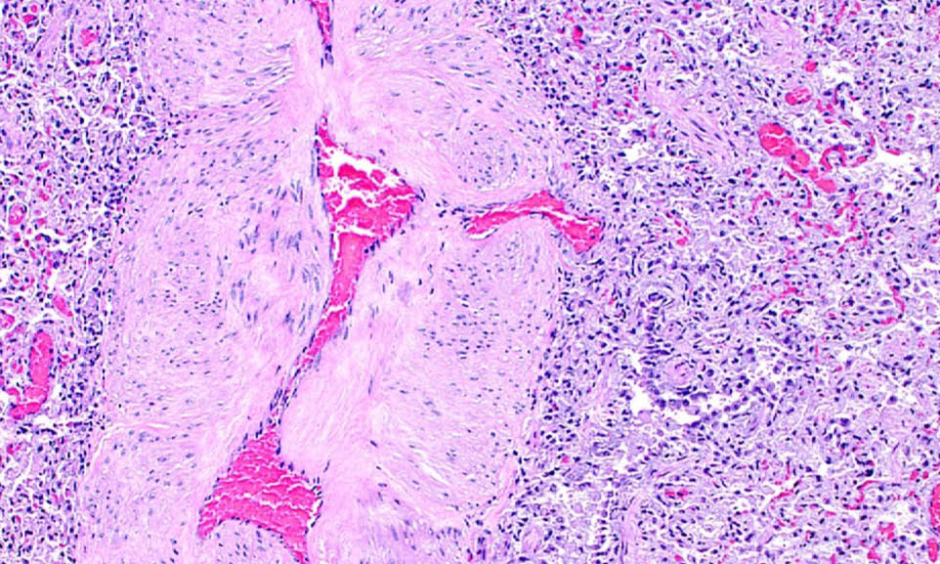Disclaimer: This content was funded by Actelion (a Janssen Pharmaceutical Company of Johnson & Johnson).
![]()
Meeting Summary
As leaders in the science of pulmonary arterial hypertension (PAH), Actelion (a Janssen Pharmaceutical Company of Johnson & Johnson) sponsored a key symposium at the 6th Systemic Sclerosis World E-Congress, which took place on the 12th – 14th July 2020. The meeting was chaired by Prof Marco Matucci-Cerinic from the University of Florence, Florence, Italy, and Assoc Prof Pavel Jansa from Charles University, Prague, Czech Republic. Speakers Prof Dinesh Khanna (University of Michigan, Ann Arbor, Michigan, USA), Prof Eric Hachulla (University of Lille, Lille, France), Prof Sean Gaine (Mater Misericordiae University Hospital, Dublin, Ireland), and Prof Janet Pope (St. Joseph’s Health Care London, London, Canada) explored pertinent topics relating to the screening, diagnosis, risk assessment, and treatment of PAH in systemic sclerosis (SSc) patients.
Assoc Prof Jansa started the symposium by reminding the audience that PAH is a very serious and a relatively prevalent complication of SSc, affecting approximately 1 in 10 SSc patients. As such, annual screening of SSc patients for PAH is recommended in the guidelines, because early detection, correct diagnosis, and optimised treatment improve patient prognosis.1 Prof Matucci-Cerinic also reiterated this message during his concluding remarks, noting specifically the importance of regular multiparametric risk assessment and combination therapy approaches in SSc-PAH.
Screening for Pulmonary Arterial Hypertension in Patients with Systemic Sclerosis
The first abstract was presented by Prof Dinesh Khanna and explored the role of screening in the diagnosis and management of PAH.
PAH is a serious complication of many connective tissue diseases (CTD), including SSc, systemic lupus erythematosus, mixed CTD, and, to a lesser extent, rheumatoid arthritis, dermatomyositis, and Sjögren’s syndrome.1,2 The prognosis of CTD-PAH patients is affected by the underlying CTD aetiology3 and disease severity,4 but patients with SSc-PAH are specifically known to have very poor prognosis.3 PAH affects approximately 13% (95% confidence interval [CI]: 8.96–17.87%) of patients with SSc, with a pooled prevalence of 8.2% (95% CI: 5.2–11.8%) based on right heart catheterisation (RHC).5 Therefore, screening for PAH in SSc patients is considered to play an important role in disease management. This is reflected in the 2015 European Society of Cardiology (ESC)/ European Respiratory Society (ERS) guidelines that recommend annual screening of SSc patients who are asymptomatic for PAH1,2 and reiterated in the 6th World Symposium on Pulmonary Hypertension (WSPH) proceedings in 2018.6
Screening can facilitate earlier diagnosis and management, potentially improving long-term outcomes.7 Data from the French and PHAROS registries demonstrated that SSc-PAH patients identified by systematic screening had reduced disease severity at diagnosis and improved long-term outcomes compared with patients diagnosed following symptomatic presentation7,8 or who had not undergone routine screening.9 Despite this evidence, significant diagnostic gaps remain in the general rheumatology community, including late referral for RHC or echocardiography and non-adherence to screening protocols.10–12 Patients with SSc-PAH usually present with non-specific symptoms often from multiple potential causes, so it is important to have a high index of suspicion in this at-risk population to carry out the appropriate tests for accurate differential diagnosis.11 It is also important to recognise risk factors in clinical practice, such as decreased diffusing capacity of the lung for carbon monoxide (DLCO), increased ratio of forced vital capacity to DLCO, the presence of anti-centromere antibodies, antinuclear antibody pattern and increased duration of SSc.13
Transthoracic echocardiography (TTE) is a recommended option for annual screening of patients with SSc,1,2,6 and a right ventricular systolic pressure >40 mmHg or tricuspid regurgitation velocity >3.0 m/sec are considered evidence of possible PAH.10 However, tricuspid regurgitation velocity is unattainable in 15–36% of patients,14,15 and patient-related factors such as obesity, lung hyperinflation, and chest wall deformity can also reduce the quality of other TTE measurements.16 Additional screening options include pulmonary function tests, exercise stress testing, and measurement of cardiac biomarkers.1,2 Cardiac peptides such as N-terminal pro-brain natriuretic peptide (NT-proBNP) have been evaluated as biomarkers in SSc.17 Although NT-proBNP alone is inadequate as a screening tool due to low sensitivity, low specificity for PAH, and low negative predictive value, it is a useful variable in composite screening algorithms.12,16,18
Composite screening algorithms can increase the sensitivity and negative predictability of testing compared to single screening methods alone.12,16,18 Utilisation of a combination of screening variables in SSc patients was systematically evaluated in DETECT – a large multicentre, cross-sectional study.19 As a result of the DETECT study, a two-step screening algorithm comprising six non-echocardiographic variables (step 1) and two echocardiographic variables (step 2) was developed. The algorithm identifies whether RHC should be performed in each patient to confirm a PAH diagnosis.19
Since its development, the DETECT algorithm has been shown to have 96-100% sensitivity in a number of studies.20-22 In a single centre study of SSc patients who had undergone at least one RHC, both DETECT and the 2009 ESC/ERS screening criteria (which recommended echocardiography in symptomatic patients) were applied to 35 SSc patients with PAH and 28 patients with no PH.20 Application of the DETECT algorithm led to a reduction in the number of missed diagnoses, a higher sensitivity, and a higher negative predictive value compared with applying the ESC/ERS criteria to the same cohort.20 Based on a recent systematic review23 and other published data, the 6th WSPH proceedings recommend the incorporation of DETECT, TTE, or forced vital capacity/DLCO ratio with elevated NT-proBNP to screen patients with SSc-spectrum disorders.6 All guidelines recommend the DETECT algorithm in patients with SSc-spectrum disorders associated with a DLCO <60% of predicted1,2 and >3 years disease duration; the 6th WSPH proceedings recommend that screening should also be considered in patients with a DLCO < 80% of predicted.6 PAH can also be present in patients with DLCO ≥ 80% of predicted, albeit to a lesser extent,16,23,24 and screening with TTE should be considered in these patients.6 Patients with SSc and borderline mean pulmonary artery pressure elevation are at high risk of developing PAH and can also be identified and monitored through screening programmes.13
While historically SSc-PAH patients have had a poor prognosis, the use of evidence-based screening algorithms can lead to improved outcomes for these patients in the modern treatment era.
SSc-PAH patients identified by systematic screening were shown to have reduced disease severity at diagnosis and improved long-term outcomes
The 6th WSPH proceedings recommend DETECT, TTE, or DLCO with elevation of NT-proBNP to screen for PAH in patients with SSc-spectrum disorders
Early and Correct Diagnosis of Pulmonary Arterial Hypertension is Key in Patients with Systemic Sclerosis
Following Prof Khanna’s presentation, Prof Eric Hachulla spoke about the reasons behind, and the implications of, delayed diagnosis of PAH.
PAH is a progressive disease of the pulmonary vasculature that eventually leads to right heart failure and death25 if left untreated. It is one of the leading causes of death in patients with SSc.26, 27 PAH associated with CTD (CTD-PAH), including SSc, is the most commonly identified type of disease-associated PAH.28 It affects 8.2% (95% CI: 5.2–11.8%) of patients with SSc based on RHC,5 occurring more commonly in patients with limited cutaneous SSc.13
The delay in diagnosing SSc-PAH from first symptoms is 2–4 years,16,29 and given that the 3-year mortality rate is 51–61%,16,30 more needs to be done to improve early diagnosis of SSc-PAH. This is illustrated by recent data from the French Pulmonary Hypertension Network and the National Systemic Sclerosis Cohort between 2006 and 2017, in which improvement in the time to diagnosis was not observed for patients with SSc-PAH.31 A lack of awareness of symptoms of SSc among primary healthcare providers and patients can cause delays in referral to expert SSc centres,32 which further impacts referral to expert pulmonary hypertension (PH) centres. In addition, SSc-PAH can progress rapidly and so early detection and treatment is vital.33,34 Earlier diagnosis of SSc-PAH allows earlier treatment to achieve the best possible response and outcomes for patients.25,16,8,35 Patients with SSc who have mild elevations in mean pulmonary artery pressure (21–24 mmHg) have a higher risk of developing severe PAH,13,33 further supporting proactive screening and earlier identification in this population.
SSc presents with a combination of vasculopathy, inflammation, autoimmunity, and fibrogenesis that can vary from patient to patient. As well as PH and lung fibrosis, many other organ systems can be involved.13 Major complications can include digital vasculopathy, gastrointestinal complications, cardiac fibrosis, scleroderma renal crisis, digital contractures, calcinosis, and acro-osteolysis.13 A precise differential diagnosis of PAH is therefore challenging as there may be concomitant disorders1,2 — careful phenotyping and diagnosis of PAH in SSc patients is critical as this impacts referral and treatment choice, and patients with other types of PH can have a worse prognosis.36,37 PH in many patients with SSc can be ascribed to interstitial lung disease (ILD, group 3 PH),36 and these patients often have a worse prognosis than patients with SSc-PAH (35% vs 56% 3-year survival, respectively).38 PAH-specific therapies have not been shown to improve dyspnoea or survival in ILD, and may even present an increased risk of hypoxia in SSc patients with ILD and PH.36 Post-capillary PH can also be due to myocardial fibrosis leading to left ventricular dysfunction (group 2 PH),36 and there is no clear evidence that PAH-specific therapies improve outcomes in SSc patients with left heart disease.1,2,39 Pulmonary veno-occlusive (PVO) components can also complicate SSc-PAH; PVO symptoms are associated with worse survival rates and increased risk of pulmonary oedema if PAH therapies are initiated,40 emphasising the importance of correct diagnosis and therapy choice. Clinically significant lung disease and left heart disease should be ruled out as part of a differential diagnosis of SSc-PAH and, in case of PAH, PVO component should be checked on the high-resolution computed tomography scan.1,2,6
SSc-PAH is typically diagnosed late, and therefore efforts to achieve an early diagnosis are critical to improve patient outcomes. SSc-PAH is complex and difficult to diagnose, as symptoms are non-specific and may be complicated by other diseases such as ILD or left heart disease. Earlier suspicion and regular screening enable patients to be referred earlier to expert centres, where a thorough differential diagnosis can exclude other types of PH before making the correct diagnosis of PAH and starting the appropriate treatments. In PAH, earlier diagnosis and treatment lead to better long-term outcomes.
SSc can lead to several different cardiopulmonary complications, including PAH, which is present in 8.2% of SSc patients based on RHC
Correct differential diagnosis of PAH at expert centres using RHC as the diagnostic gold standard is necessary prior to any initiation of PAH therapies
Assessing Risk to Make Timely Treatment Decisions
Prof Sean Gaine progressed the symposium to the topic of risk assessment in PAH: an important element of treatment decision-making and patient follow-up.
PAH affects approximately 1 out of 10 patients with SSc18 and is responsible for almost 30% of all SSc-related deaths.26 When compared with patients with idiopathic or other CTD-associated PAH, patients with SSc-PAH have higher mortality rates despite similar or less severe baseline haemodynamics.41-44 SSc-PAH patients can deteriorate rapidly, and disease progression events can occur frequently even in patients with mild or no PAH symptoms at diagnosis.34
Following diagnosis of PAH, risk assessment is essential both at baseline and at regular intervals during the course of therapy to determine prognosis and to allow treatment decisions to be tailored to the patient’s status.1,2,35 Several methods of assessing risk have been proposed,45-51 including the Registry to Evaluate Early and Long-term Pulmonary Arterial Hypertension Disease Management (REVEAL) risk calculator and the risk stratification parameters in the ESC/ERS 2015 Guidelines.1,2,47
The REVEAL risk score calculator factors in modifiable and non-modifiable parameters such as comorbidities and gender, and provides a score that can be used to categorise patients as being at low, intermediate, or high risk of death.47,52 The calculator was recently updated to include new and revised variables including all-cause hospitalisations within the last 6 months.52 The REVEAL risk calculator has been validated in a number of patient populations52 including in those with SSc-PAH (n=292) enrolled in the PHAROS registry.53
The ESC/ERS 2015 Guidelines proposed a set of modifiable invasive and non-invasive parameters to help stratify patients according to low, intermediate, or high risk of 1-year mortality.2,1 Based primarily on clinical evidence and expert opinion, these stratified parameters have since been validated in three European registries (COMPERA, SPAHR, and the French Pulmonary Hypertension registry), comprising more than 3000 incident patients.4,54,55 Results from the French registry showed that the number of low-risk criteria (World Health Organization [WHO]/New York Heart Association [NYHA] functional class I–II, 6-minute walk distance [6MWD] >440 m, right atrial pressure <8 mmHg and cardiac index ≥2.5 L·min-1·m-2) at baseline and follow-up accurately determined the risk of death or lung transplantation.55 Further analyses also showed that using only non-invasive criteria (WHO/NYHA functional class I–II, 6MWD >440 m, BNP <50 ng·L−1 or NT-proBNP <300 ng·L−1 55) were sufficient to discriminate for survival and clinical worsening-free survival in PAH patients (idiopathic, heritable, and drug-induced55) at baseline and follow-up.56 In the SPAHR and COMPERA analyses, PAH patients identified as low risk using composite scoring had a better prognosis at baseline and follow-up.4,54 Independent of the methods used, these studies highlight the importance of improving to or maintaining a low-risk status for improved prognosis. These methodologies for risk assessment based on the ESC/ERS 2015 Guidelines have also been specifically validated in SSc-PAH patients in two large cohorts including over 600 patients with SSc-PAH.57,58 In both of these studies, a reduced risk of mortality was significantly associated with a low-risk status at baseline and follow-up.57,58
It is clear from the ongoing research in this area that regardless of which method is used for risk assessment, the most crucial aspect is that a patient’s risk is evaluated at baseline and regularly at follow-up, including in those patients with SSc-PAH. It is essential that the assessment is comprehensive and includes multiple parameters, which when viewed alongside clinical gestalt can give a good estimate of how the patient’s disease will progress, and consequently provide guidance on optimal therapeutic strategies. Each risk assessment method comes with advantages and disadvantages. Ultimately, it is up to the individual physician to decide which method is most suitable for their clinical practice.
Delays in diagnosis adversely impact clinical outcomes and patients often wait too long for a PAH diagnosis. However, advancements in disease management, which include comprehensive risk assessment and combination therapy regimens, have led to encouraging improvements in patient outcomes. Attaining and maintaining a low-risk status in patients is the ultimate treatment goal in PAH.1,2,59
SSc-PAH patients can deteriorate rapidly, and disease progression events can occur frequently even in patients with mild or no PAH symptoms at diagnosis.
Stratification of patients according to their 1-year mortality risk is recommended to guide treatment decisions, both at diagnosis and regularly at each follow-up visit.
Treatment Strategies in Systemic Sclerosis-Associated Pulmonary Arterial Hypertension: Clinical Evidence and the Patient Perspective
Prof Janet Pope closed the symposium with her presentation of recent clinical trial data showcasing the most recent advances that have been made in relation to treatment strategies for patients with PAH.
PAH is a serious complication of SSc,34 and it is essential to initiate therapy early, addressing the three current treatment pathways (endothelial, nitric oxide, and prostacyclin pathways). If left untreated, the prognosis for SSc-PAH is very poor with mortality at 1 year as high as 50%.60 The emergence of new treatments and use of combination therapy has drastically improved survival for SSc-PAH patients.1 Both the 2015 ESC/ERS and 2017 European League Against Rheumatism (EULAR) guidelines1,2,61 recommend that patients with SSc-PAH should be treated according to the evidence-based treatment algorithm. Growing evidence has established initial double combination therapy as a key strategy for treating patients with PAH, including those with SSc-PAH. The 6th WSPH proceedings recommend initial monotherapy in a minority of PAH patients only.59 A structured follow-up, particularly early after treatment initiation, should allow for the identification of early signs of disease progression to intensify treatment.1,2
Dual combination therapy regimens are increasingly used for patients with a low- or intermediate-risk status, and there is growing evidence to support this approach in CTD-PAH patients. SERAPHIN and AMBITION62,63 were the first randomised controlled trials (RCT) to provide long-term data supporting the use of combination therapy with an endothelin receptor antagonist (ERA) and a phosphodiesterase-type 5 inhibitor (PDE5i) in PAH patients, including those with CTD-PAH. These findings have been confirmed in a recent meta-analysis of six RCT with 963 CTD-PAH patients, in which combination therapy significantly reduced the risk of clinical worsening events by 27% (p=0.002) and showed a trend towards increased 6MWD by 21.4 m (p=0.32) compared with monotherapy.64
The GRIPHON study, the first RCT to generate long-term outcome data for a drug targeting the prostacyclin (PGI2) pathway, included the largest population of CTD-PAH patients studied to date (N=334);65,66 of whom 170 had SSc-PAH.66 The oral IP prostacyclin receptor agonist selexipag reduced the risk of a morbidity/mortality event by 41% versus placebo in the PAH-CTD subgroup, an effect consistent with the overall GRIPHON population. Three quarters of the CTD-PAH patients were receiving targeted therapy at baseline, with either an ERA, a PDE5i, or both; suggesting that targeting all three currently targetable pathways may improve patient outcomes even further than dual combination therapy.65,66
In a retrospective analysis of real-world data, treatment of newly diagnosed patients (including those with CTD-PAH) with any combination of an ERA and a PDE-5i resulted in improvements in functional class, exercise capacity, and haemodynamic parameters.67 In a study of 15 incident patients treated with initial macitentan and riociguat combination therapy, 1-year follow-up data showed a reduction to low-risk score in 47% of patients with no unexpected safety events.68 Real-world data from the OPUS registry have demonstrated that combination therapy has been widely adopted in CTD-PAH patients, with almost two-thirds (62%) of SSc-PAH patients already receiving another PAH therapy at the time of macitentan initiation.69 Survival of SSc-PAH patients in OPUS is similar to that observed for idiopathic PAH patients.69 Furthermore, data from OPUS and OrPHeUS confirm the overall safety profile of macitentan in combination therapy in clinical practice.70
An increased awareness of the patient’s perspective and the adoption of a patient-focused approach to disease management is vital to reduce the impact that PAH has on patients’ lives. The value of implementing a patient-focussed approach is recognised in the ESC/ERS 2015 Guidelines1,2 and a patient’s perspective taskforce at the 6th WSPH in 2018.71
Assessment of wellbeing using patient surveys provides insight into the patient’s experiences including how they are coping. Data from such surveys have shown that up to half of patients experience mild to severe depression.72 Furthermore, patients have reported social isolation, distressing financial pressures, and frustration caused by delays in diagnosis.73,74 The results of a survey also showed a major impact of PAH on quality of life (QoL) in 60% of respondents,75 with a correlation between QoL and long-term outcomes recognised.76 Treatment should therefore incorporate multidimensional care elements into management strategies for PAH.
Advances in treatment strategies for patients with PAH have improved long-term outcomes, although prognosis in those with SSc-PAH remains poor. Increased awareness of risk-factors, early detection, and early use of initial combination therapy are key to improving outcomes in this patient population. Management of PAH should be holistic and incorporate the patient’s perspective to improve both QoL and long-term outcomes.
Due to the aggressive nature of PAH in SSc patients, early combination therapy addressing all three pathological pathways is critical to attenuate disease progression.
Adopting an individualised patient-focussed approach to improve overall wellbeing and QoL is an important aspect of PAH management.
References:
- Galiè N et al. 2015 ESC/ERS guidelines for the diagnosis and treatment of pulmonary hypertension: the joint task force for the diagnosis and treatment of pulmonary hypertension of the European Society of Cardiology (ESC) and the European Respiratory Society (ERS): endorsed by: Association for European Paediatric and Congenital Cardiology (AEPC), International Society for Heart and Lung Transplantation (ISHLT). Eur Respir J. 2015;46(4):903-75.
- Galiè N et al. 2015 ESC/ERS guidelines for the diagnosis and treatment of pulmonary hypertension: the joint task force for the diagnosis and treatment of pulmonary hypertension of the European Society of Cardiology (ESC) and the European Respiratory Society (ERS): endorsed by: Association for European Paediatric and Congenital Cardiology (AEPC), International Society for Heart and Lung Transplantation (ISHLT). Eur Heart J. 2016;37(1):67-119.
- Chung L et al. Unique predictors of mortality in patients with pulmonary arterial hypertension associated with systemic sclerosis in the REVEAL registry. Chest. 2014;146(6):1494-504.
- Hoeper MM et al. Mortality in pulmonary arterial hypertension: prediction by the 2015 European pulmonary hypertension guidelines risk stratification model. Eur Respir J. 2017;50(2):1700740.
- Yang X et al. Prevalence of pulmonary arterial hypertension in patients with connective tissue diseases: a systematic review of the literature. Clin Rheumatol. 2013;32(10):1519-31.
- Frost A et al. Diagnosis of pulmonary hypertension. Eur Respir J. 2019;53(1):1801904.
- Kolstad KD et al. Long-term outcomes in systemic sclerosis-associated pulmonary arterial hypertension from the Pulmonary Hypertension Assessment and Recognition of Outcomes in Scleroderma Registry (PHAROS). Chest. 2018;154(4):862-71.
- Humbert M et al. Screening for pulmonary arterial hypertension in patients with systemic sclerosis: clinical characteristics at diagnosis and long-term survival. Arthritis Rheum. 2011;63(11):3522-30.
- Chung L et al. Survival and predictors of mortality in systemic sclerosis-associated pulmonary arterial hypertension: outcomes from the pulmonary hypertension assessment and recognition of outcomes in scleroderma registry. Arthritis Care Res (Hoboken). 2014;66(3):489-95.
- Khanna D et al. Recognition of pulmonary hypertension in the rheumatology community: lessons from a Quality Enhancement Research Initiative. Clin Exp Rheumatol. 2014;32(6 Suppl 86):S-21-7.
- Saygin D, Domsic RT. Pulmonary arterial hypertension in systemic sclerosis: challenges in diagnosis, screening and treatment. Open Access Rheumatol. 2019;11:323-33.
- Morrisroe K et al. Epidemiology and disease characteristics of systemic sclerosis-related pulmonary arterial hypertension: results from a real-life screening programme. Arthritis Res Ther. 2017;19:42.
- Denton CP, Khanna D. Systemic sclerosis. Lancet. 2017;390(10103):1685-99.
- Gladue H et al. Screening and diagnostic modalities for connective tissue disease-associated pulmonary arterial hypertension: a systematic review. Semin Arthritis Rheum. 2014;43(4):536-41.
- Soukup T et al. Application of the DETECT algorithm for detection of risk of pulmonary arterial hypertension in systemic sclerosis: data from a Czech tertiary centre. Rheumatology. 2016;55(1):109-14.
- Weatherald J et al. Screening for pulmonary arterial hypertension in systemic sclerosis. Eur Respir Rev. 2019;28(153):190023.
- Allanore Y et al. High N-terminal pro-brain natriuretic peptide levels and low diffusing capacity for carbon monoxide as independent predictors of the occurrence of precapillary pulmonary arterial hypertension in patients with systemic sclerosis. Arthritis Rheum. 2008;58(1):284-91.
- Kiely DG et al. Screening strategies for pulmonary arterial hypertension. Eur Heart J Suppl. 2019;21(Suppl K):K9-20.
- Coghlan JG et al. Screening strategies for pulmonary arterial hypertension. Ann Rheum Dis. 2014;73:1340-9.
- Guillén-Del Castillo A et al. High sensitivity and negative predictive value of the DETECT algorithm for an early diagnosis of pulmonary arterial hypertension in systemic sclerosis: application in a single center. Arthritis Res Ther. 2017;19:135.
- Hao Y et al. A comparison of the predictive accuracy of three screening models for pulmonary arterial hypertension in systemic sclerosis. Arthritis Res Ther. 2015;17(1):7.
- Vandecasteele E et al. Screening for pulmonary arterial hypertension in an unselected prospective systemic sclerosis cohort. Eur Respir J. 2017;49(5):1602275.
- Young A et al. Update of screening and diagnostic modalities for connective tissue disease-associated pulmonary arterial hypertension. Semin Arthritis Rheum. 2019;48(6):1059-67.
- Schwaiger JP et al. Screening patients with scleroderma for pulmonary arterial hypertension and implications for other at-risk populations. Eur Respir Rev. 2013;22(130):515-25.
- Vachiery JL et al. How to detect disease progression in pulmonary arterial hypertension. Eur Respir Rev. 2012;21(123):40-7.
- Steen VD, Medsger TA. Changes in causes of death in systemic sclerosis, 1972-2002. Ann Rheum Dis. 2007;66(7):940-4.
- Tyndall AJ et al. Causes and risk factors for death in systemic sclerosis: a study from the EULAR Scleroderma Trials and Research (EUSTAR) database. Ann Rheum Dis. 2010;69(10):1809-15.
- Humbert M et al. Pulmonary arterial hypertension in France: results from a national registry. Am J Resp Crit Care. 2006;173(9):1023-30.
- Hachulla E et al. Is pulmonary arterial hypertension really a late complication of systemic sclerosis? Chest. 2009;136(5):1211-9.
- Launay D et al. Survival in systemic sclerosis-associated pulmonary arterial hypertension in the modern management era. Ann Rheum Dis. 2013;72(12):1940-6.
- Hachulla E et al. Survival improved in patients aged ≤70 years with systemic sclerosis-associated pulmonary arterial hypertension during the period 2006 to 2017 in France. Chest. 2020;157(4):945-54.
- Distler O et al. Factors influencing early referral, early diagnosis and management in patients with diffuse cutaneous systemic sclerosis. Rheumatology (Oxford). 2018;57(5):813-7.
- Coghlan JG et al. Incidence of pulmonary hypertension and determining factors in patients with systemic sclerosis. Eur Respir J. 2018;51(4):1701197.
- Mihai C et al. Factors associated with disease progression in early-diagnosed pulmonary arterial hypertension associated with systemic sclerosis: longitudinal data from the DETECT cohort. Ann Rheum Dis. 2018;77(1):128-32.
- Gaine S, McLaughlin V. Pulmonary arterial hypertension: tailoring treatment to risk in the current era. Eur Respir Rev. 2017;26(146):170095.
- Launay D et al. Pulmonary hypertension in systemic sclerosis: different phenotypes. Eur Respir Rev. 2017;26(145):170056.
- Bourji KI et al. Poor survival in patients with scleroderma and pulmonary hypertension due to heart failure with preserved ejection fraction. Pulm Circ. 2017;7(2):409-20.
- Lefevre G et al. Survival and prognostic factors in systemic sclerosis-associated pulmonary hypertension: a systematic review and meta-analysis. Arthritis Rheum. 2013;65(9):2412-23.
- Vachiéry JL et al. Pulmonary hypertension due to left heart disease. Eur Respir J. 2019;53(1):1801897.
- Günther S et al. Computed tomography findings of pulmonary venoocclusive disease in scleroderma patients presenting with precapillary pulmonary hypertension. Arthritis Rheum. 2012;64(9):2995-3005.
- Fisher MR et al. Clinical differences between idiopathic and scleroderma-related pulmonary hypertension. Arthritis Rheum. 2006;54(9):3043-50.
- Clements PJ et al. The pulmonary arterial hypertension quality enhancement research initiative: comparison of patients with idiopathic PAH to patients with systemic sclerosis-associated PAH. Ann Rheum Dis. 2011;71(2):249-52.
- Ramjug S et al. Idiopathic and systemic sclerosis-associated pulmonary arterial hypertension: a comparison of demographic, hemodynamic, and MRI characteristics and outcomes. Chest. 2017;152(1):92-102.
- Chung L et al. Characterization of connective tissue disease-associated pulmonary arterial hypertension from REVEAL: identifying systemic sclerosis as a unique phenotype. Chest. 2010;138(6):1383-94.
- D’Alonzo GE et al. Survival in patients with primary pulmonary hypertension. Results from a national prospective registry. Ann Intern Med. 1991;115(4):343-9.
- Benza RL et al. Predicting survival in pulmonary arterial hypertension: insights from the Registry to Evaluate Early and Long-Term Pulmonary Arterial Hypertension Disease Management (REVEAL). Circulation. 2010;122(2):164-72.
- Benza RL et al. The REVEAL registry risk score calculator in patients newly diagnosed with pulmonary arterial hypertension. Chest. 2012;141(2):354-62.
- Humbert M et al. Survival in incident and prevalent cohorts of patients with pulmonary arterial hypertension. Eur Respir J. 2010;36(3):549-55.
- Thenappan T et al. Survival in pulmonary arterial hypertension: a reappraisal of the NIH risk stratification equation. Eur Respir J. 2010;35(5):1079-87.
- Thenappan T et al. Validation of the pulmonary hypertension connection equation for survival prediction in pulmonary arterial hypertension. Chest. 2012;141(3):642-50.
- Lee WT et al. Predicting survival in pulmonary arterial hypertension in the UK. Eur Respir J. 2012;40(3):604-11.
- Benza RL et al. Predicting survival in patients with pulmonary arterial hypertension: the REVEAL risk score calculator 2.0 and comparison with ESC/ERS-based risk assessment strategies. Chest. 2019;156(2):323-37.
- Mullin CJ et al. Validation of the REVEAL prognostic equation and risk score calculator in incident systemic sclerosis-associated pulmonary arterial hypertension. Arthritis Rheumatol. 2019;71(10):1691-700.
- Kylhammar D et al. A comprehensive risk stratification at early follow-up determines prognosis in pulmonary arterial hypertension. Eur Heart J. 2018;39(47):4175-81.
- Boucly A et al. Risk assessment, prognosis and guideline implementation in pulmonary arterial hypertension. Eur Respir J. 2017;50:1700889.
- Humbert M et al. Risk assessment in pulmonary arterial hypertension and chronic thromboembolic pulmonary hypertension. Eur Respir J. 2019;53(6):1802004.
- Mercurio V et al. Risk assessment in scleroderma patients with newly diagnosed pulmonary arterial hypertension: application of the ESC/ERS risk prediction model. Eur Respir J. 2018;52(4):1800497.
- Weatherald J et al. Haemodynamics and serial risk assessment in systemic sclerosis associated pulmonary arterial hypertension. Eur Respir J. 2018;52(4):1800678.
- Galiè N et al. Risk stratification and medical therapy of pulmonary arterial hypertension. Eur Respir J. 2019;53(1):1801889.
- Koh ET et al. Pulmonary hypertension in systemic sclerosis: an analysis of 17 patients. Br J Rheumatol. 1996;35(10):989-93.
- Kowal-Bielecka O et al. Update of EULAR recommendations for the treatment of systemic sclerosis. Ann Rheum Di. 2017;76(8):1327-39.
- Galiè N et al. Initial use of ambrisentan plus tadalafil in pulmonary arterial hypertension. N Engl J Med. 2015;373:834-44.
- Coghlan JG et al. Initial combination therapy with ambrisentan and tadalafil in connective tissue disease-associated pulmonary arterial hypertension (CTD-PAH): subgroup analysis from the AMBITION trial. Ann Rheum Dis. 2017;76(7):1219-27.
- Pan J et al. Comparison between the efficacy of combination therapy and monotherapy in connective tissue disease associated pulmonary arterial hypertension: a systematic review and meta-analysis. Clin Exp Rheumatol. 2018;36(6):1095-102.
- Sitbon O et al. Selexipag for the treatment of pulmonary arterial hypertension. N Engl J Med. 2015;373(26):2522-33.
- Gaine S et al. Selexipag for the treatment of connective tissue disease-associated pulmonary arterial hypertension. Eur Respir J. 2017;50:1602493.
- Sitbon O et al. Initial dual oral combination therapy in pulmonary arterial hypertension. Eur Respir J. 2016;47(6):1727-36.
- Sulica R et al. Clinical and hemodynamic benefit of macitentan and riociguat upfront combination in patients with pulmonary arterial hypertension. Pulm Circ. 2019;9(1):2045894019826944.
- Chin K et al. OPUS registry: treatment patterns and safety of macitentan in patients with pulmonary arterial hypertension associated with systemic sclerosis (PAH-SSc). Chest. 2017;152(4):A999-1000.
- Kim N et al. Macitentan in pulmonary hypertension (PH): data from OPUS and OrPHeUS real-world data sets. Eur Resp J. 2019;54:PA5458.
- McGoon MD et al. The importance of patient perspectives in pulmonary hypertension. Eur Respir J. 2019;53(1):1801919.
- Gin-Sing W. Pulmonary arterial hypertension: a multidisciplinary approach to care. Nurs Stand. 2010;24(38):40-7.
- Armstrong I et al. The patient experience of pulmonary hypertension: a large cross-sectional study of UK patients. BMC Pulm Med. 2019;19:67.
- Guillevin L et al. Understanding the impact of pulmonary arterial hypertension on patients’ and carers’ lives. Eur Respir Rev. 2013;22(130):535-42.
- Pulmonary Hypertension Association (PHA) UK. Living with PH. 2016. Available at: http://www.phauk.org/living-with-pulmonary-hypertension/living-ph-report/. Last accessed: 16 July 2020.
- Mehta S et al. Macitentan improves health-related quality of life for patients with pulmonary arterial hypertension: results from the randomized controlled SERAPHIN trial. Chest. 2017;151(1):106-18.
Date of preparation July 2020 – EM-38782








